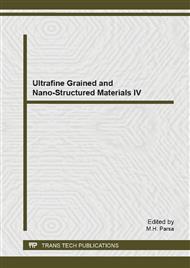[1]
Salvetat, J-P, J-M Bonard, NH Thomson, AJ Kulik, L Forro, W Benoit, and L Zuppiroli, Mechanical Properties of Carbon Nanotubes. Appl. Phys. A, no. 3 (1999): 255-60.
DOI: 10.1007/s003390050999
Google Scholar
[2]
Iijima, Sumio, Charles Brabec, Amitesh Maiti, and Jerzy Bernholc, Structural Flexibility of Carbon Nanotubes. J. Chem. Phys. 104 (1996): (2089).
DOI: 10.1063/1.470966
Google Scholar
[3]
Das, Maumita, Chetna Dhand, G Sumana, AK Srivastava, N Vijayan, R Nagarajan, and BD Malhotra, Zirconia Grafted Carbon Nanotubes Based Biosensor for M. Tuberculosis Detection. Appl. Phys. Lett., no. 14 (2011): 143702-02-3.
DOI: 10.1063/1.3645618
Google Scholar
[4]
Grossiord, Nadia, Joachim Loos, Oren Regev, and Cor Koning, Toolbox for Dispersing Carbon Nanotubes into Polymers to Get Conductive Nanocomposites, Chem. Mater., no. 5 (2006): 1089-99.
DOI: 10.1021/cm051881h
Google Scholar
[5]
Zanello, Laura P, Bin Zhao, Hui Hu, and Robert C Haddon, Bone Cell Proliferation on Carbon Nanotubes. Nano Lett., no. 3 (2006): 562-67.
DOI: 10.1021/nl051861e
Google Scholar
[6]
Shin, Jung-Hoo, and Seong-Hyeon Hong, Microstructure and Mechanical Properties of Single Wall Carbon Nanotube Reinforced Yttria Stabilized Zircona Ceramics, Mater. Sci. Eng., A: (2012).
DOI: 10.1016/j.msea.2012.07.001
Google Scholar
[7]
Tucci, A, and L Esposito, Microstructure and Tribological Properties of ZrO2 Ceramics, Wear 172, no. 2 (1994): 111-19.
DOI: 10.1016/0043-1648(94)90278-x
Google Scholar
[8]
Zhou, Ji Ping, Qian Ming Gong, Ke Yi Yuan, Jian Jun Wu, Chen Sha Li, and Ji Liang, The Effects of Multiwalled Carbon Nanotubes on the Hot-Pressed 3mol% Yttria Stabilized Zirconia Ceramics, Mater. Sci. Eng., A: no. 1 (2009): 153-57.
DOI: 10.1016/j.msea.2009.05.014
Google Scholar
[9]
Bocanegra-Bernal, MH, J Echeberria, J Ollo, A Garcia-Reyes, C Domínguez-Rios, A Reyes-Rojas, and A Aguilar-Elguezabal, A Comparison of the Effects of Multi-Wall and Single-Wall Carbon Nanotube Additions on the Properties of Zirconia Toughened Alumina Composites, Carbon 49, no. 5 (2011).
DOI: 10.1016/j.carbon.2010.12.042
Google Scholar
[10]
Sarkar, Soumya, and Probal Kr Das, Microstructure and Physicomechanical Properties of Pressureless Sintered Multiwalled Carbon Nanotube/Alumina Nanocomposites, Ceram. Int. 38, no. 1 (2012): 423-32.
DOI: 10.1016/j.ceramint.2011.07.023
Google Scholar
[11]
Sun, Zhenyu, Valeria Nicolosi, David Rickard, Shane D Bergin, Damian Aherne, and Jonathan N Coleman, Quantitative Evaluation of Surfactant-Stabilized Single-Walled Carbon Nanotubes: Dispersion Quality and Its Correlation with Zeta Potential, J. Phys. Chem. C 112, no. 29 (2008).
DOI: 10.1021/jp8021634
Google Scholar
[12]
Duan, WenHui, Quan Wang, and Frank Collins, Dispersion of Carbon Nanotubes with SDS Surfactants, Chem. Sci. 2, no. 7 (2011): 1407-13.
Google Scholar
[13]
Jiang, Linqin, Lian Gao, and Jing Sun, Production of Aqueous Colloidal Dispersions of Carbon Nanotubes, J. Colloid Interface Sci. 260, no. 1 (2003): 89-94.
DOI: 10.1016/s0021-9797(02)00176-5
Google Scholar
[14]
Alias, Hajar, and Phang Wei Ho, Synthesis and Flow Behaviour of Carbon Nanotubes Nanofluids, J. Technol. 51, no. 1 (2012): 143–56.
Google Scholar
[15]
González-Julián, Jesús, Pilar Miranzo, M Isabel Osendi, and Manuel Belmonte, Carbon Nanotubes Functionalization Process for Developing Ceramic Matrix Nanocomposites, J. Mater. Chem. 21, no. 16 (2011): 6063-71.
DOI: 10.1039/c0jm03885g
Google Scholar
[16]
Osorio, AG, ICL Silveira, VL Bueno, and CP Bergmann, H2SO4 /HNO3 /HCL Functionalization and Its Effect on Dispersion of Carbon Nanotubes in Aqueous Media, Appl. Surf. Sci. 255, no. 5 (2008): 2485-89.
DOI: 10.1016/j.apsusc.2008.07.144
Google Scholar
[17]
Chiang, Long Y, Ravindra B Upasani, and John W Swirczewski, Process of Forming Polysubstituted Fullerenes, US Patents, (1993).
Google Scholar
[18]
Munkhbayar, B, MdJ Nine, Jinseong Jeoun, Munkhjargal Bat-Erdene, Hanshik Chung, and Hyomin Jeong, Influence of Dry and Wet Ball Milling on Dispersion Characteristics of the Multi-Walled Carbon Nanotubes in Aqueous Solution with and without Surfactant, Powder Technol. 234 (2013).
DOI: 10.1016/j.powtec.2012.09.045
Google Scholar
[19]
Munkhbayar, B, Jinseong Jeoun, Junhyo Kim, Hanshik Chung, and Hyomin Jeong, Dispersion Characteristics of Multi-Walled Carbon Nanotubes Produced by Mechanical Grinding with Changing Rotation Speeds, Powder Technol. (2012).
Google Scholar
[20]
Rastogi, Richa, Rahul Kaushal, SK Tripathi, Amit L Sharma, Inderpreet Kaur, and Lalit M Bharadwaj, Comparative Study of Carbon Nanotube Dispersion Using Surfactants, J. Colloid Interface Sci. 328, no. 2 (2008): 421-28.
DOI: 10.1016/j.jcis.2008.09.015
Google Scholar
[21]
O. Vasylkiv and Y. Sakka, Synthesis and Colloidal Processing of ZirconiaNanopowder, J. Am. Ceram. Soc. 84 (2001): 2489-2494.
Google Scholar


